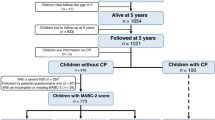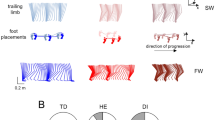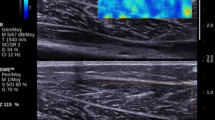Abstract
Kinematic characteristics of reaching movements of the dominant arm were assessed in 51 sitting preterm children who were aged 2–11 y and had cerebral palsy (CP), including 33 with spastic hemiplegia and 18 with bilateral CP (Bi-CP). Reference data of 29 typically developing children were present. The results indicated that the quality of reaching movements from the dominant arm of children with CP was significantly worse than that of typically developing children. This held true in particular for the children with Bi-CP. For example, reaching movements of children with CP took more time and consisted less often of one movement unit. The quality of reaching was related to the severity of lesion present on the neonatal ultrasound scan of the brain, the severity of motor disorder, the degree of spasticity, and the ability to perform activities of daily life. The last indicates that movements of the dominant arm in children with spastic hemiplegia and Bi-CP deserve clinical attention.
Similar content being viewed by others
Log in or create a free account to read this content
Gain free access to this article, as well as selected content from this journal and more on nature.com
or
Abbreviations
- Bi-CP:
-
bilateral cerebral palsy
- CP:
-
cerebral palsy
- GMFCS:
-
Gross Motor Function Classification System
- MU:
-
movement unit
- PEDI:
-
Pediatric Evaluation of Disability Inventory
- PVL:
-
periventricular leukomalacia
- SH:
-
spastic hemiplegia
References
Jeannerod M 1984 The timing of natural prehension movements. J Mot Behav 16: 235–254
Von Hofsten C 1979 Development of visually directed reaching: the approach phase. J Hum Mov St 5: 160–178
Fallang B, Saugstad OD, Hadders-Algra M 2000 Goal directed reaching and postural control in supine position in healthy infants. Behav Brain Res 115: 9–18
Von Hofsten C 1991 Structuring of early reaching movements: a longitudinal study. J Mot Behav 23: 280–292
Konczak J, Borutta M, Topka H, Dichgans J 1995 The development of goal-directed reaching in infants: hand trajectory formation and joint torque control. Exp Brain Res 106: 156–168
Konczak J, Dichgans J 1997 The development toward stereotypic arm kinematics during reaching in the first 3 years of life. Exp Brain Res 117: 346–354
Kuhtz-Buschbeck JP, Stolze H, Jöhnk K, Boczek-Funcke A, Illert M 1998 Development of prehension movements in children: a kinematic study. Exp Brain Res 122: 424–432
Kuhtz-Buschbeck JP, Boczek-Funcke A, Illert M, Joehnk K, Stolze H 1999 Prehension movements and motor development in children. Exp Brain Res 128: 65–68
Schneiberg S, Sveistrup H, McFadyen B, McKinley P, Levin MF 2002 The development of coordination for reach-to-grasp movements in children. Exp Brain Res 146: 142–154
Van der Heide JC, Otten B, Van Eykern LA, Hadders-Algra M 2003 Development of postural adjustments during reaching in sitting children. Exp Brain Res 151: 32–45
Utley A, Sugden D 1998 Interlimb coupling in children with hemiplegic cerebral palsy during reaching and grasping at speed. Dev Med Child Neurol 40: 396–404
Volman MJ, Wijnroks A, Vermeer A 2002 Effect of task context on reaching performance in children with spastic hemiparesis. Clin Rehabil 16: 684–692
Steenbergen B, Hulstijn W, de Vries A, Berger M 1996 Bimanual movement coordination in spastic hemiparesis. Exp Brain Res 110: 91–98
Steenbergen B, Hulstijn W, Lemmens IH, Meulenbroek RG 1998 The timing of prehensile movements in subjects with cerebral palsy. Dev Med Child Neurol 40: 108–114
Steenbergen B, Van Thiel E, Hulstijn W, Meulenbroek RG 2000 The coordination of reaching and grasping in spastic hemiparesis. Hum Mov Sci 19: 75–105
Van Thiel E, Steenbergen B 2001 Shoulder and hand displacements during hitting, reaching, and grasping movements in hemiparetic cerebral palsy. Motor Control 5: 166–182
Kluzik J, Fetters L, Coryell J 1990 Quantification of control: a preliminary study of effects of neurodevelopmental treatment on reaching in children with spastic cerebral palsy. Phys Ther 70: 65–78
Fetters L, Kluzik J 1996 The effects of neurodevelopmental treatment versus practice on the reaching of children with spastic cerebral palsy. Phys Ther 76: 346–358
Bohannon RW, Smith MB 1987 Interrater reliability of a modified Ashworth scale of muscle spasticity. Phys Ther 67: 206–207
Custers JW, Wassenberg-Severijnen JE, Van der Net J, Vermeer A, Hart HT, Helders PJ 2002 Dutch adaptation and content validity of the “Pediatric Evaluation of Disability Inventory (PEDI).”. Disabil Rehabil 24: 250–258
Palisano R, Rosenbaum P, Walter S, Russell D, Wood E, Galuppi B 1997 Development and reliability of a system to classify gross motor function in children with cerebral palsy. Dev Med Child Neurol 39: 214–223
Levene MI, Fawer CL, Lamont RF 1982 Risk factors in the development of intraventricular haemorrhage in the preterm neonate. Arch Dis Child 57: 410–417
De Vries L, Eken P, Dubowitz LM 1992 The spectrum of leukomalacia using cranial ultrasound. Behav Brain Res 49: 1–6
van der Heide JC, Begeer C, Fock JM, Otten E, Stremmelaar E, Van Eykern LA, Hadders-Algra M 2004 Postural control during reaching in preterm children with cerebral palsy. Dev Med Child Neurol 46: 253–266
Otten E 2000 DataMonster, a software package running on an Apple Macintosh computer for signal analysis and modelling for research in motor control. In: Winters JM, Crago PE (eds) Biomechanics and Neural Control of Movement and Posture. Springer-Verlag, New York, pp 665–667
Messier J, Adamovich S, Berkinblit M, Tunik E, Poizner H 2003 Influence of movement speed on accuracy and coordination of reaching movement to memorized targets in three-dimensional space in a deafferented subject. Exp Brain Res 150: 399–416
Hadders-Algra M, Brogren E, Katz-Salamon M, Forssberg H 1999 Periventricular leucomalacia and preterm birth have different detrimental effects on postural adjustments. Brain 122: 727–740
van der Fits IB, Flikweert ER, Stremmelaar EF, Martijn A, Hadders-Algra M 1999 Development of postural adjustments during reaching in preterm infants. Pediatr Res 46: 1–7
Fallang B, Saugstad OD, Grøgaard J, Hadders-Algra M 2003 Kinematic quality of reaching movements in preterm infants. Pediatr Res 53: 836–842
Uvebrant P 1988 Hemiplegic cerebral palsy. Aetiology and outcome. Acta Paediatr Scand Suppl 345: 1–100
Hadders-Algra M 2000 The neuronal group selection theory: promising principles for the understanding and treating of developmental motor disorders. Dev Med Child Neurol 42: 707–715
Mercuri E, Jongmans M, Bouza H, Haataja L, Rutherford M, Henderson S, Dubowitz L 1999 Congenital hemiplegia in children at school age: assessment of hand function in the non-hemiplegic hand and correlation with MRI. Neuropediatrics 30: 8–13
Gordon AM, Charles J, Duff SV 1999 Fingertip forces during object manipulation in children with hemiplegic cerebral palsy. II: bilateral coordination. Dev Med Child Neurol 41: 176–185
Gordon AM, Lewis SR, Eliasson AC, Duff SV 2003 Object release under varying task constraints in children with hemiplegic cerebral palsy. Dev Med Child Neurol 45: 240–248
Custers JW, van der Net J, Hoijtink H, Wassenberg-Severijnen JE, Vermeer A, Helders PJ 2002 Discriminative validity of the Dutch Pediatric Evaluation of Disability Inventory. Arch Phys Med Rehabil 83: 1437–1441
Latash ML, Anson JG 1996 What are “normal movements” in atypical populations?. Behav Brain Sci 19: 55–68
Ketelaar M, Vermeer A, Hart H, van Petegem-van Beek E, Helders PJ 2001 Effects of functional therapy program on motor abilities of children with cerebral palsy. Phys Ther 81: 1534–1545
Acknowledgements
We thank Prof. Dr. O.F. Brouwer for critical and valuable remarks on a previous draft of this manuscript. L.A. van Eykern, A.A. Kingma-Balkema, and Dr. J.J.A.M. Schaap are kindly acknowledged for skillful technical assistance.
Author information
Authors and Affiliations
Corresponding author
Additional information
This study was supported by the Johanna KinderFonds (grant 19990021), the Dr. W.M. Phelps-Stiching voor Spastici (grant 99.058), and the Gratama Stichting/Groninger Universiteits Fonds.
Rights and permissions
About this article
Cite this article
van der Heide, J., Fock, J., Otten, B. et al. Kinematic Characteristics of Reaching Movements in Preterm Children with Cerebral Palsy. Pediatr Res 57, 883–889 (2005). https://doi.org/10.1203/01.PDR.0000157771.20683.14
Received:
Accepted:
Issue date:
DOI: https://doi.org/10.1203/01.PDR.0000157771.20683.14
This article is cited by
-
A systematic review of instrumented assessments for upper limb function in cerebral palsy: current limitations and future directions
Journal of NeuroEngineering and Rehabilitation (2024)
-
Connectivity modulations induced by reach&grasp movements: a multidimensional approach
Scientific Reports (2021)
-
Ipsilesional functional recruitment within lower mu band in children with unilateral cerebral palsy, an event-related desynchronization study
Experimental Brain Research (2018)
-
Novel kinematic indices for quantifying upper limb ability and dexterity after cervical spinal cord injury
Medical & Biological Engineering & Computing (2017)
-
Measuring upper limb function in children with hemiparesis with 3D inertial sensors
Child's Nervous System (2017)



